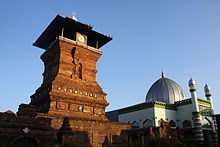Menara Kudus Mosque
| Menara Kudus Mosque | |
|---|---|
Masjid Menara Kudus | |
 | |
| Religion | |
| Affiliation | Sunni Islam |
| Location | |
| Location | Kudus, Central Java, Indonesia |
| Geographic coordinates | 6°48′14″S 110°49′56″E / 6.80389°S 110.83222°E |
| Architecture | |
| Type | Mosque |
| Date established | 1549 |
The Menara Kudus Mosque (
Architecture


It preserves pre-Islamic architectural forms such as old Javanese split doorways, ancient Hindu-Buddhist influenced
In front of the minaret and around the compound are walls and gateways in the old
The pre-Islamic elements suggest the complex has incorporated a pre-existing Hindu-Javanese structure. The mosque has been rebuilt several times removing evidence of what the original structure looked like. The Majapahit style gates, walls, and minaret that appear so incongruous today may have blended more harmoniously with the main structure (which probably had a
-
The tower and domed mosque main building.
-
The bedug drum in the pavilion atop the menara (minaret).
-
Majapahit style split gate and red brickwork
-
Mosque gate (Pintu gerbang)
-
Cemetery (Makam)
See also
- Indonesian architecture
- Mosques in Indonesia
References
- ISBN 0-86442-314-4.
- ^ ISBN 962-593-232-1
- ^ ISBN 962-593-244-5
- ISBN 0-333-57689-6.















